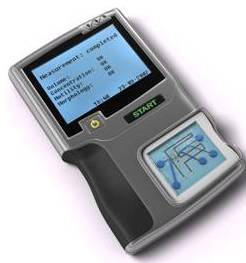Chip for measuring male fertility is first stage in home testing kit
23 February 2010
A new ‘fertility chip’, developed by researchers at the University of Twente’s MESA+ Institute for Nanotechnology, can accurately count spermatozoa in semen. This is an important step towards the development of a compact device for reliable ‘pre-scanning’ of male fertility. The researchers are publishing the invention of the chip in the scientific journal Lab on a Chip.
Every year more than 10,000 couples in the Netherlands apply for help because of involuntary childlessness. A sperm analysis is typically the first step of fertility research. Testing sperm quality requires stringent pre-test preparations and a specialized laboratory. Tests often have to be repeated two to five times for sufficient reliability. If men can carry out the tests in the privacy of their own home this makes the procedure much less awkward for them, the probability of a reliable diagnosis is increased, and the costs of testing reduced.
Sperm counting chip
Concentration is an important indication of sperm count: the norm for fertility is 20 million spermatozoa per millilitre of ejaculate. Simple home tests are available, but these can only indicate that the sperm count is 'above or below the norm'. These tests are too limited because they do not actually measure the concentration of spermatozoa. The chip developed by researcher Loes Segerink, however, can accurately count spermatozoa. An artist's impression of what an analyser with the chip could look like is shown below.
 On
the new chip, the spermatozoa flow through a fluid channel, above
which electrodes are fitted. When a cell flows under this 'bridge',
its electrical resistance changes momentarily, and this event is
counted. It is important that the count distinguishes between
spermatozoa and other particles or cells in the fluid: if other
particles are included the count will be unreliable.
On
the new chip, the spermatozoa flow through a fluid channel, above
which electrodes are fitted. When a cell flows under this 'bridge',
its electrical resistance changes momentarily, and this event is
counted. It is important that the count distinguishes between
spermatozoa and other particles or cells in the fluid: if other
particles are included the count will be unreliable.
Segerink added minuscule balls to the fluid to test its selectivity. The method proved to be selective enough to distinguish between the balls and the spermatozoa. White blood cells were also distinguished by the chip. The number of white blood cells tells us something about sperm quality and so this is important additional information for the gynaecologist.
Activity and shape
Concentration is not the only indicator of sperm quality. Spontaneous activity — also known as motility — and the shape of the spermatozoa are also important factors. Further research will need to establish whether these two quality characteristics can be measured in a similar manner, so that a compact device can be developed in which a chip can be inserted for single use. The user will only be able to see that the test has been completed successfully; the gynaecologist will inform him of the actual results personally.
Reference
1. Loes Segerink, Ad Sprenkels, Paul ter Braak, Istvan Vermes and Albert van den Berg. On-chip determination of spermatozoa concentration using electrical impedance measurements. Lab on a Chip. It has been published online in the form of an Advance Publication, and will appear in print in the near future.